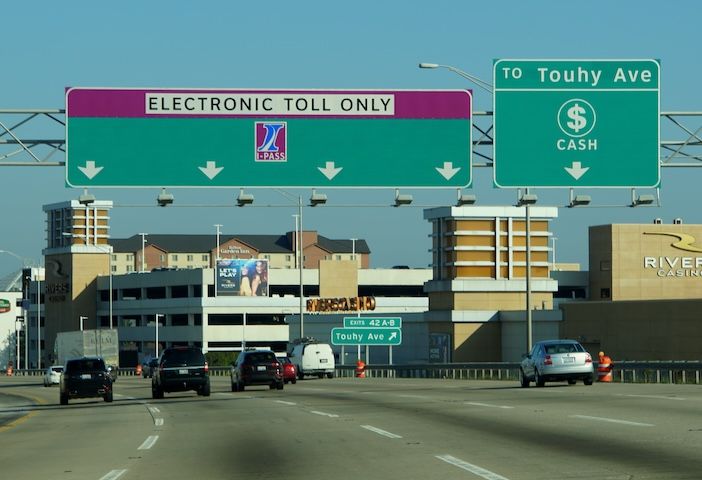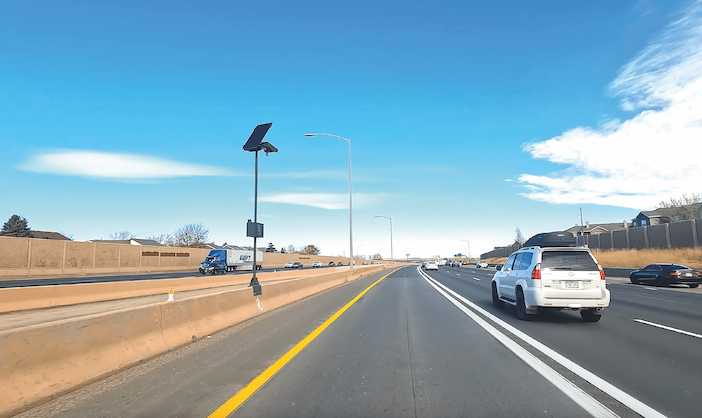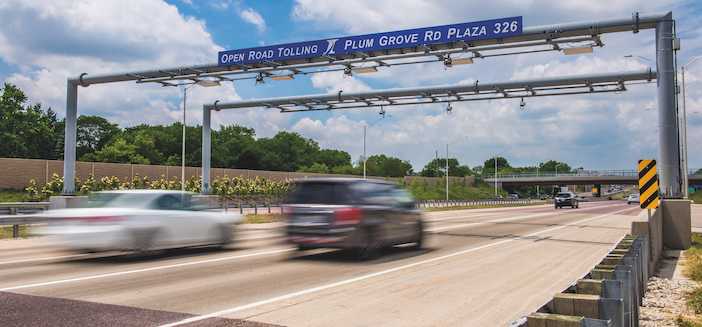From ensuring equitable access in Illinois to engaging with communities in Michigan and improving safety in Colorado, the latest winners of the IBTTA’s Toll Excellence Awards are proving that running a successful toll road is about much more than just revenue generation
The International Bridge, Tunnel & Turnpike Association (IBTTA) Toll Excellence Award winners 2024 were presented at the organization’s Annual Meeting in October 2024, with Illinois Tollway, winner in the Customer Service and Marketing outreach category, taking the coveted President’s Award for its I-Pass Assist project – designed to make toll services more accessible for low-income families. The equity-focused program lowers financial barriers for those earning less than 250% of federal poverty guidelines. Drivers who qualify for I-Pass Assist receive a 50% toll discount and can use their transponder anywhere E-ZPass is accepted.
Minimizing the financial burden of setting up an account, I-Pass Assist offers a $4 setup fee, down from $30, for I-Pass. Automatic replenishment fees have been lowered from $20 to $4 and the system eliminates invoice fees.

“Customer service is at the heart of everything we do,” says Cassaundra Rouse, executive director at Illinois Tollway. “We saw an opportunity to address hardships and ensure equitable access to transportation. We collaborated across departments within the Illinois Tollway and we also worked in partnership with state agencies to make sure that I-Pass Assist is addressing equity and ensuring access to underserved and financially vulnerable communities.”
Illinois Tollway identified that those who have struggled to maintain account balances or received fines for missed tolls can end up avoiding toll roads altogether with alternative routes which are often less convenient. “By facilitating easier access to I-Pass, the I-Pass Assist program has addressed a critical need, enabling equitable toll payment and enhancing transportation accessibility for underserved populations,” says Rouse.
“Our goal has always been to make sure no one is left behind when it comes to essential transportation by providing financial relief to those who need it most”
Cassaundra Rouse, executive director, Illinois Tollway
I-Pass Assist was developed alongside state agencies to streamline the automated application process to offer near-instant approval. A secure web form is used so applicants can submit the necessary information to confirm if the household income falls below the threshold or if the household is using any food and cash assistance programs. Applications are automatically cross-referenced and integrated with existing state databases such as the Illinois Department of Revenue and the Illinois Department of Human Services to validate income and residency.
Customers are notified via email if they meet the eligibility requirements and an I-Pass is automatically shipped free of charge. After the I-Pass is received, the customer can then add money to their I-Pass Assist account to activate the system. So far, more than $3.7 million in invoice fees for missed tolls have been waived since the program was introduced.
“Our goal has always been to make sure that no one is left behind when it comes to access to essential transportation, by providing financial relief to those in society who need it most,” says Rouse. “I-Pass Assist is already serving as a model in the wider industry, as we all work together toward creating transportation systems that are accessible to everyone.”

Illinois Tollway conducted community focused outreach campaigns using digital platforms and direct communication to engage with potential I-Pass Assist customers. The outreach efforts helped to improve awareness and enrollment in the program.
“One of the primary motivations behind I-Pass Assist is promoting social equity and reducing barriers to economic mobility,” says Rouse. “By addressing the financial burden of tolls on low-income residents, I-Pass Assist aligns with a broader movement toward equity and fairness in public services, a priority for state leaders and the Illinois Tollway.”
Since the launch of I-Pass Assist, several toll agencies have considered similar programs, “Michigan and Oregon are examining toll-equity initiatives as they expand new toll facilities,” says Rouse. “The Metropolitan Transportation Commission in the San Francisco Bay Area, for example, began a pilot program in April 2023 to reduce toll costs for low-income drivers on I-880 express lanes.”
However, Rouse believes that the I-Pass Assist scheme is still leading the way in terms of equitable access. “Many of these other equity initiatives are limited, often focusing on congestion pricing strategies rather than comprehensive toll equity. In contrast, I-Pass Assist provides consistent, system-wide support to low-income users regardless of toll rates, demonstrating a commitment to equitable tolling that others are just beginning to adopt.”
Engaging with the community
The IBTTA Award for Excellence in Social Responsibility was awarded to Windsor-Detroit Bridge Authority (WDBA) for the Gordie Howe International Bridge Project, with the IBTTA panel saying the project: “exemplifies excellence in social responsibility, fostering social change through extensive community engagement and environmental stewardship while contributing billions to local economic growth.”

The $4.5 billion project, which is expected to be completed in the fall of 2025, comprises a bridge over the Detroit River connecting Windsor, Ontario and Detroit, Michigan; a Canadian Port of Entry (POE); a US POE; and the Michigan Interchange which will connect with Interstate 75. The WDBA will operate the bridge once it is open.
The social impact of the project is illustrated by the fact it has created over 11,400 new jobs, with 42% filled by local workers, and engaged 275+ local businesses. It will invest $23 million in community improvements and has delivered a visual arts program that includes indigenous art and a commemorative piece recognizing the Underground Railroad, all informed by community engagement.
“The new bridge will ensure the safe, efficient and secure movement of people and goods across the Detroit River to support the economies of Ontario, Michigan, Canada and the US”
Grant Hilbers, chief capital officer, WDBA
The bridge itself is six lanes wide and around 1.5 miles long, making it one of the top five longest bridges in North America. A multi-use path caters for pedestrians and cyclists. “The crossing will be equipped with smart technology,” says WDBA chief capital officer, Grant Hilbers. “For example, when commercial traffic is heavy, we will have the capability to convert passenger lanes to commercial lanes.”
The new roads will feature a traffic surveillance system, lane control and traveler information systems, video feeds for traffic monitoring, demand-driven dedicated lanes and video monitoring to capture unauthorized movement near trucks. To inform users of border wait times, travel-time detection systems will be used.
The Canadian side of the bridge will have 24 primary inspection lanes while the US side will have 36, making it the largest land POE on the US-Canada border. Underlining the importance of the project, Hilbers says, “[it] addresses the regional transportation needs of redundancy, capacity, system connectivity and improved border processing for the busiest commercial land border crossing between Canada and the United States. More than 25% of overall Canada-US trade per year crosses at Windsor-Detroit.
“The new bridge will ensure the safe, efficient and secure movement of people and goods across the Detroit River to support the economies of Ontario, Michigan, Canada and the US and encourage new investment between Canada and the United States, helping to maintain and create thousands of jobs and opportunities on both sides of the border. Further information about the tolling system will be made in the new year, closer to the fall 2025 opening date.”
Safety via enhanced enforcement
The Colorado Transportation Investment Office (CTIO) won the 2024 IBTTA Excellence Award for Safety, for its implementation of a new enforcement program. After a two-year trial period, Blissway’s Wireless Autonomous Lane Enforcer (WAL-E) technology is now live on the I-70 Mountain Corridor.
“We could tell through our tolling equipment that people were still using [the express lane] when it was closed”
Kelly Brown, chief toll operations officer, CTIO
Due to snowfall in the state, express lanes cannot be separated by physical barriers and are instead marked by double white lines, which leaves them open for drivers to use even when they are officially closed.
The mountain express lane is typically closed during the week but chief toll operations officer, Kelly Brown, explains, “We could tell through our tolling equipment that people were still using it when it was closed and we knew who they were, because our equipment was telling us their transponder number was or license plate number.”
Improper use of express lanes included weaving in and out to avoid toll gantries, oversized vehicles using the lanes and use when the lane is closed. Discussing the impact of weaving, Brown says, “We knew that was causing a lot of side-swipe and rear-end collisions because of the speed differential between the two lanes.”
WAL-E is a self-contained, solar-powered wireless and cellular system that can either be mounted to a gantry or positioned independently. Units can be placed closer together and in separate locations from existing gantries which drivers are avoiding.

To identify drivers violating the rules, WAL-E works by establishing if a vehicle was pictured in a general-purpose lane at one point, then in the express lane at a different point. Due to the positioning of the WAL-E systems, the team is able to establish if there were any legal ingress and egress zones between the two.
“The WAL-E captures images and sends the images to the cloud where Blissway uses human experts to manually review every image,” says tolling maintenance supervisor, Josh Gerace. “We positioned the WAL-Es one before and typically one after the toll point and that’s usually where we catch a lot of the violators weaving around the toll points. We also put several other cameras throughout the corridor in longer stretches, to capture the vehicles that are ingressing and egressing to speed around other traffic. Then also in areas where you enter the express lane, or right before the express lane begins because a lot of drivers are very impatient and they don’t want to wait.”
In the year since the program has been introduced, CDOT has seen an 80% reduction in violations. “We’re seeing that of the people that are getting a violation sent to them, 80% are getting one violation, and of the ones that do two violations, 60% of those are not getting a third violation,” says Brown. Due to the success of the program so far, the WAL-E system will be deployed on three additional corridors in the state in December 2024.
This feature first appeared in the December 2024 edition of TTi magazine
Additional images: AdobeStock





